Many potential aspiring piano players ask: Is learning piano easy? By asking this question, you may have an underlying concern about whether or not it’s going to be too difficult for you. Taking too long to learn piano can be another concern.
The ease of learning piano depends on the style. Classical piano is more difficult because it’s based on reading music as written by the composer. Popular piano is easier because the popular song form consists of chords, patterns, lyrics and repetition which are easier to remember and learn.
The Traditional Piano Approach
Is learning piano easy with traditional methods? Traditional piano lessons are the most time consuming method to learn piano. I would not say it’s easy. I would say that there are certain aspects of traditional piano instruction that are beneficial to an aspiring piano player. Overall, it takes much longer to learn to play piano traditionally because it centers on reading music which is a time consuming skill to master.
From the beginning, traditional piano instruction is administered through method books that progress from one grade or level to another. These method books are often supplemented with other piano study materials such as exercises and drills.
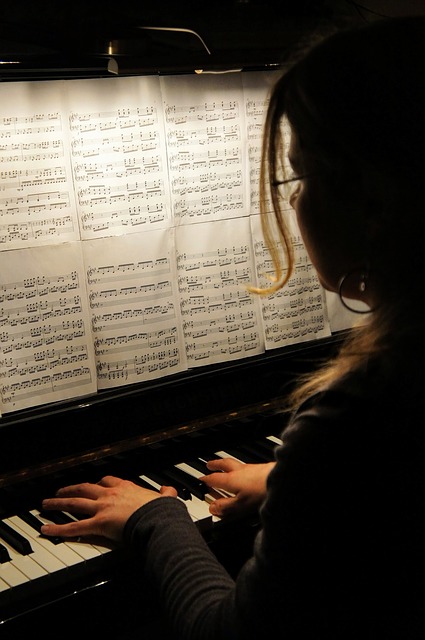
Since this is considered formal piano lessons, there are many rules concerning music theory that students are required to adhere to. Any type of improvisation or experimenting on the keys is typically frowned upon by traditional instructors.
The reason for discouraging such practice is a belief that a student may develop bad habits that will inhibit progress later on. It’s my belief that this could only be true if a beginning piano student habitually studies piano in a counterproductive way.
Traditional piano instruction is most effective when beginning students are at a very early age. This is usually before the age of 7 years old. Older children as well as adults make up for a smaller percentage of beginning piano students.
For the traditional piano instruction approach, the earlier the better. A child is still at a developmental stage to obtain the technique possibilities needed to learn and progress. One of the biggest challenges is not always for the young students. It’s for the parents and instructors to keep them motivated and engaged.
The Non-traditional Piano Approach
A non-traditional piano approach is often a more contemporary method to learn piano. This is non-classical instruction and/or self instruction. In other words, this approach is for learning and playing popular music. This is anything non-classical such as but not limited to rock, Pop, folk, jazz, blues, country, reggae, hip hop, R&B and any other style that is not classical music.
So, Is learning piano easy with a non-traditional approach? I will say that it’s easier to learn piano with a non-traditional approach than a traditional approach. You don’t have the formalities and strict adherence to rules in popular music.
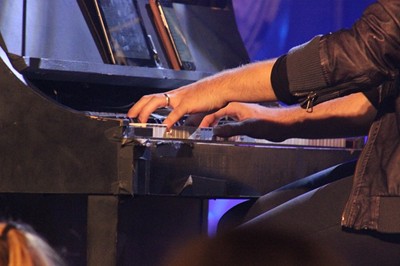
This doesn’t mean that there aren’t guidelines about music theory and concepts that are better adhered to at times. Let’s just say that non-traditional piano instruction has more flexibility as it pertains to the “rules”.
Classical repertoire has complex melodies and harmonies. And the composer often wrote arrangements for more than one instrument such as an orchestra. Popular music is typically simpler because you’re working more with chords and patterns. Lyrics are a big part of popular music with sections that repeat themselves. This makes popular songs easier to learn and remember.
Is Learning Piano Easy With the Traditional or Non-traditional Approach?
Learning piano is much easier with the non-traditional approach. This of course means that the goal is to play popular music which is of the popular song form. This does not mean that you are unable to play classical music pieces if you learn from the non-traditional approach. But any classical songs in your own repertoire would not fit among the most complex in the genre.

The interesting thing about well known classical pieces such as Pachelbel’s canon in d, fur elise and Beethoven’s moonlight sonata to name a few, is that these pieces have the character of popular songs. They’re memorable. The melodies don’t whiz by at an extremely fast tempo that your ear can’t grab onto. The harmonies are also quite simple compared to other classical pieces.
In other words, you could hum or whistle the melodies to these songs. This is unlike more complex classical pieces where the melody notes are so fast, you may have trouble even identifying the melodies if you heard them at random.
The popular song form consists of song sections that are easily definable and repeat themselves.
The Popular Song Structure Basic Elements
- Introduction
- Verse
- Chorus
- Bridge
- Outro
There is also song structure known as AABA form. These four sections are used in 32 bars of music in which A is the verse and B is the chorus. There are also many variations on the AABA form but we won’t go any deeper in this article.
The point is: Popular music is simple, repetitive and easy to remember. This is why popular music is preferred over classical for most people. We’ve been listening to popular music on the radio as well as recordings for all of our lives and we really connect with the songs we grew up with and continue to listen to.
6 Ways to Make Learning Piano Easier
I’ve discovered that whatever a person is trying to learn to do, there are fundamental concepts involved that they must be thoroughly familiar with. If you want to be a skilled football player, there’s a lot of drills such as passing, receiving, running etc. that’s going to make the difference once you get in the game. Being a skilled piano player is no different. So let’s look at some of those to make learning piano easier for you.
1 Keys of Music
Familiarize yourself with Major and minor keys of music. A key of music is simply a pattern of 7 different notes that melodies and harmonies are drawn from. A key of music is also known as a scale.
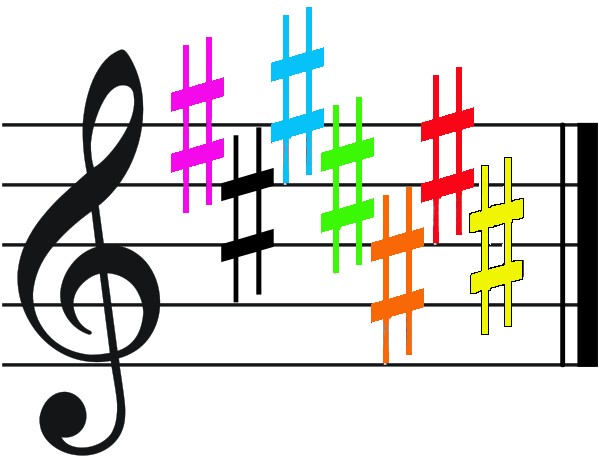
This is a point of contention for many aspiring piano players because it’s viewed as an exercise of boredom and drudgery. You should overcome this limiting belief that causes so many piano students to want to quit.
Choose one key of music to study and master it. Don’t move on to other keys until you know it thoroughly. Use spaced repetition. In other words, give your mind a rest. Don’t spend copious amounts of time trying to learn a key. Space out your practice time and you’ll find that you’ll have several opportunities for a fresh state of mind when you come back to your study session.
2 Triads
Whether or not you aspire to play classical or popular music, know that all music consists of chords. They may be in different forms such as block chords or arpeggios. But you will find the presence of chords (also known as harmony) in all genres of music.
Triads are the most fundamental chords in music. Triads are three note chords. They come in four forms: Major, minor, diminished and augmented. Knowing Major triads alone will give you the tools to play the harmony of virtually any popular song.
Master learning the 12 Major chords first. You can then move on to minor chords and so on. Remember triads can also be inverted so learn to recognize and play them in any position.
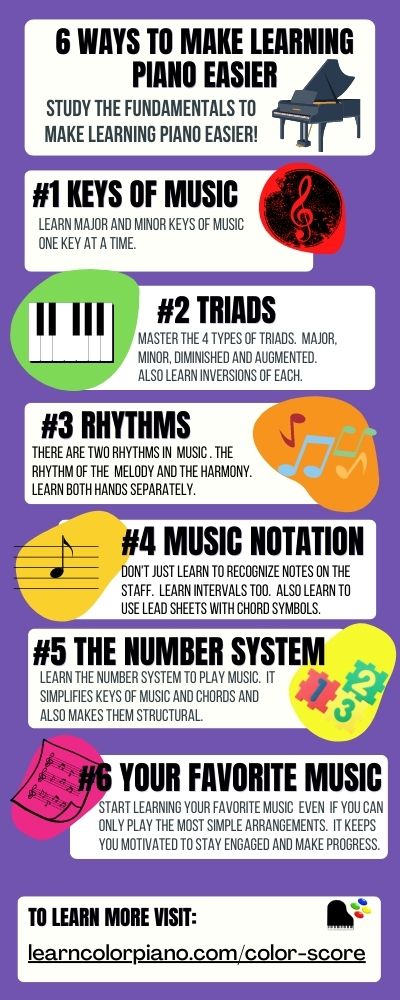
3 Rhythms
You have two different rhythms in music. The rhythm of the melody and rhythm of the harmony. One can be simple and the other complex and vice versa. But it’s important to understand this concept. Depending upon the complexity involved in playing both hands, it’s very useful to suspend one while you master the other.
If you need to play one hand only while learning a song, do so and don’t feel as though it’s a step backward no matter what skill level you’re at. Once you develop the skill and dexterity of one hand, switch to the other hand and master its part. This really is how one develops the skill to play rhythms. Try this and I’m confident you’ll impress yourself.
4 Music Notation
The difficulty of reading traditional music notation is responsible for so many quitters at the piano. Your piano playing skills are more likely to be based on your reading ability if you’re a traditional piano student. If so, you’ll need to spend more time developing this skill if this is the case for you.
Recognize intervals on the staff instead of simply recognizing notes. This speeds up music reading by adding another dimension of notation to make it easier to read. For example, if two notes are a Major 3rd apart, it’s easy to recognize them as the first two notes of a Major chord.
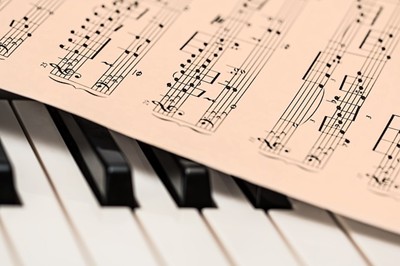
However, reading music doesn’t only encompass the traditional sheet music form. There’s something called a lead sheet. It’s a tool exclusively for popular music but there are some classical versions of lead sheets.
They contain the treble clef with a simple melody line and chord symbols. The purpose of this type of notation is to provide the musician with the essential elements of a song with minimal music reading.
With the knowledge of chords, melodies and rhythms, the lead sheet can be a musician’s best friend. You can add your own style to a song and still have the guidance of a piece of sheet music without having to read so many notes.
A collection of lead sheets is called a fake book which contain large selections of songs. You can also create leads sheets with apps and software programs. Investing in sight reading instructional materials will help your music reading skills in whichever type you plan on using.
5 The Number System
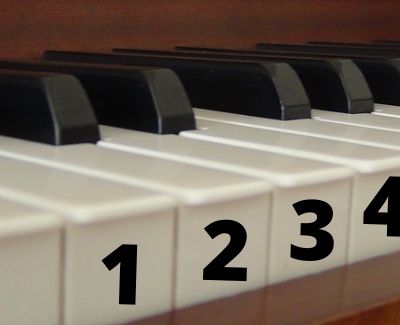
The number system is my favorite tool in music. It’s been around for a very long time. It’s also known as the Nashville number system but really existed long before the term was coined. The number system is a numerical sequence of each tone in a key of music. These tones are used to construct chords and chord progressions.
The main benefit of the number system is the structural identity of music. If you know the numerical formula of a chord or progression in one key, it can be easily transposed to any other key. Even though the chords themselves change, the numbers do not. It’s this simplicity that makes the number system such a valuable tool.
You can learn the number system by playing each tone in a key of music while reciting its number. The key to effectively learning the number system is to not use all five fingers of your right hand, but use only one finger. This way your kinesthetic sense (physical memory) doesn’t enable you to subconsciously learn the tones without you consciously learning them. The goal is to name any numbered tone without having to find it first with your hand on the keyboard.
6 Your Favorite Music
Second to the complexity of reading music, the inability to play one’s favorite songs is responsible for so many quitters at the piano. I can attest that was a part of my losing interest as a student when I was a kid.
Study materials and method books are often uninspiring and dull as far as music is concerned. So the longer it takes for you to play your favorite music, the less likely it will be to keep yourself engaged in learning piano. So, is learning piano easy as long as you can play your favorite songs? I would say it has a high motivation factor.
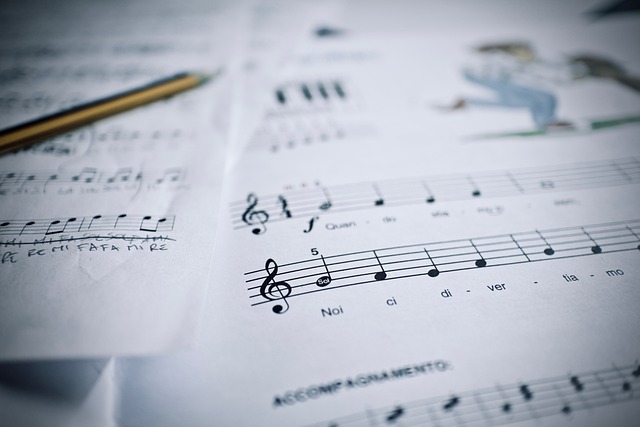
If you have to find the most basic arrangements of your most favorite songs. Do so. This will keep you motivated and inspire you to keep progressing until you can play more advanced arrangements.
Make a list of the songs you want to play as a goal. Keep this in front of you as you continue your music journey at the piano. Fun and enjoyment makes anything easier and this will be your experience as you play your favorite music.
So is learning piano easy for anyone that wants to learn? I believe it is with the right approach, the right goals and motivation.
Until next time, Go Play!
Greg Lee
Latest posts by Greg Lee (see all)
- What is a minor/Major 7 Chord? - October 26, 2023
- 7 Chord Substitutions that Professionals Use - October 19, 2023
- 5 Simple Chord Tricks to Sound Amazing - October 5, 2023



